
Royal Winton Chintz Floral Porcelain Tea Set (15 Pieces)
Royal Winton chintz floral porcelain teapot, milk jug, sugar bowl and four cup saucer plate sets, (15 items), the teapot 17 cm high
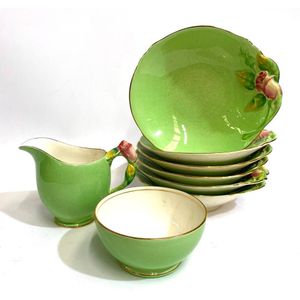
Royal Winton Green Floral Creamer, Sugar Bowl, Dessert Bowls
A Royal Winton creamer & sugar bowl & six dessert bowls, green with floral detail
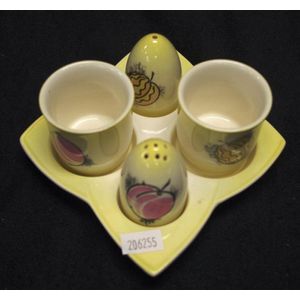
Royal Winton Egg Set with Salt and Pepper
Royal Winton Grimwades egg set with two egg cups and salt and pepper

Green Rosebud Royal Winton Tableware Set
Five Royal Winton green rosebud table wares comprising a coffee pot, teapot, lidded sugar, teapot stand, gravy boat & under saucer

Royal Winton Gypsy Caravan Coffee Set with Crazing
Five piece part Royal Winton coffee set pattern 'Gypsy' caravan, comprising a coffee pot, two cups, sugar and creamer some crazing

Royal Winton Red Roof Breakfast Set with Tray
Royal Winton 'Red Roof' breakfast set comprising: teapot, teacup, sugar bowl, milk jug, and toast rack, on a matching tray.

Royal Winton 'Tiger Lily' Three-Piece Teaset
Three piece Royal Winton 'Tiger Lily' teaset including teapot, height 17 cm, jug, and covered sugar bowl, marked to bases and # 8875.

Royal Winton 'Hazel' Breakfast Set with Teapot and Tray
Royal Winton 'Hazel' part breakfast set including: teapot, toast rack, milk jug, and tray, (some teacup and sugar bowl pieces available for possible restoration).

Tiger Lily Breakfast Set with Matching Tray
Royal Winton 'Tiger Lily' breakfast set comprising: teapot, teacup, sugar bowl, milk jug, and toast rack, on matching yellow tray.

Royal Winton Porcelain Collection
Various Royal Winton porcelain items. Chintz 'Marguerite' trivet; sugar bowl and sandwich plate; 'Beehive' butter dish and cover; floral lustre vase minor chip to foot; and a chintz 'Lilac Time' box and cover by Empire Pottery.
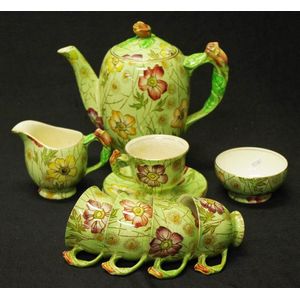
Royal Winton Rosebud Coffee Set with 5 Cups & 6 Saucers
Vintage Royal Winton ' Rosebud' coffee set including 5 cups and 6 saucers, crazing to interior of cups, cream jug, sugar bowl, and coffee pot.

Royal Winton Summertime 6-Piece Breakfast Set with Tray
Royal Winton 'Summertime' six piece breakfast set, comprising of teapot, sugar, creamer, toast rack, cup, and fitted tray

Royal Winton 'Richmond' 6-Piece Breakfast Set with Tray
Royal Winton 'Richmond' six piece breakfast set, comprising of teapot, sugar, creamer, toast rack, cup, and fitted tray

Royal Winton 'Sweet Pea' 21-Piece Teaset
Twenty one piece Royal Winton 'Sweet Pea' teaset comprising of 6 trios, cake plate, sugar and creamer

Grimwades Peter Rabbit Teaset with 8 pieces
Grimwades Peter Rabbit Teaset, teapot, sugar and cream, 2 cups, saucer and plates (both cups af)

Royal Winton Floral Tea Set for 6
Royal Winton floral 'Royalty' tea service for 6 well painted in a bouquet of flowers and consisting of 6 trios, 1 gravy boat, 1 sugar, 1 tray, teapot and 1 plate. Condition: good, minor wear from use

Bairnsfather Ware Head Rack Plate and Sugar Basins Set
Grimwades Bairnsfather Ware head rack plate jug, tumbler (af), two graduated sugar basins
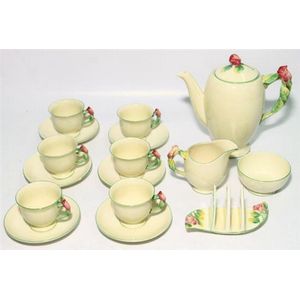
Royal Winton 'Rosebud' Coffee Set for Six
A Royal Winton 'Rosebud' coffee set for six, comprising 6 cups & saucers, pot, sugar & creamer, toastrack, in excellent condition, height 20 cm [pot]

Royal Winton Levin Tea Set with Tray
Royal Winton tea for one set, 'Levin' pattern, comprising a teapot, teacup, milk jug, sugar bowl and toast rack on tray

Summertime Set with Floral Plates
Royal Winton ' Summertime' sugar and creamer, together with 2 all over floral cake plates

Royal Winton Anemone Teaset with 14 pieces
Royal Winton 'Anemone' teaset comprising of 6 trios, a cake plate, milk jug and sugar bowl

Royal Winton Sweet Pea Tea Set for Six
A Royal Winton 'Sweet Pea' tea set for six, comprising six each cups, saucers and plates, sugar and creamer, and two cake plates

Marguerite Dinner Set with Teapot & Comport
19 piece part Royal Winton dinner set. Marguerite pattern, including teapot & sugar bowl, comport, three various milk jugs, four dessert bowls etc.

Royal Winton Royalty Dejeuner Set - 6 Pieces
Royal Winton Royalty Dejeuner set. 6 pces, including teapot, milk jug & sugar, toast rack & underplate (jug handle restored)

Art Deco Royal Winton Coffee Set with 6 Cups
Art Deco Royal Winton coffee set, comprising of coffee pot, milk jug, sugar bowl and 6 cups with saucers,

Royal Winton Breakfast Sets (2)
A Royal Winton 'Hazel' pattern breakfast set, comprising tea pot, tea cup, milk, sugar, toast rack, on integral tray. Width 24 cm. Together with another in the Petunia pattern. Width 26 cm. (2 sets)

Royal Winton Tiger Lily Tea Set
Royal Winton tiger lily part tea service, comprising of six cups,saucers and plates, sugar, creamer and bon bon dish as inspected.

Royal Winton Chintz Tea Set with 20+ Pieces
Royal Winton all over chintz part teaset, consisting of four cup and saucers, extra cup, square sugar (as inspected) and creamer, teapot as inspected, 6 side plates and a cake plate

Vintage Jug Set with Royal Winton Sugar Bowl
Four various vintage jugs including Royal Winton jug with matching sugar bowl

Royal Winton Tea Service Set
Royal Winton tea service teapot, coffee, creamer and sugar. Largest measures 19 cm tall.
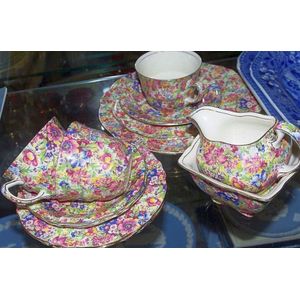
Royal Winton Tea Set with Cake Plate, Sugar and Milk
Royal Winton part tea set comprising three trios, cake plate, sugar and milk

Royal Winton Green-Ground 'Rosebud' Set
A group of Royal Winton green-ground 'Rosebud' pieces, third quarter 20th century, six pieces comprising a larger jug, sugar basin, toast rack, dishes, and a stand, printed and painted marks underside each. Height 14.5 cm. (largest)






 Loading more...
Loading more...